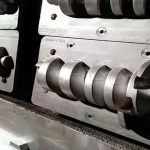As we all know, nowadays, 3D printing and various printing materials (plastics, rubber, composite materials, metals, wax and sand) have brought great convenience to the automotive, aerospace, healthcare, and medical industries. Many companies have 3D printing is integrated in its supply chain, which also includes mold making.
So what are the advantages of 3D printing to make molds?
There are five advantages to using 3D printing to make molds:
The mold production cycle is shortened
3D printing molds shorten the entire product development cycle and become the source of innovation. In the past, companies sometimes chose to postpone or abandon product design updates due to the need to invest a lot of money in manufacturing new molds. By reducing mold production preparation time and enabling existing design tools to be quickly updated, 3D printing enables companies to afford more frequent mold replacements and improvements. It can make the mold design cycle keep up with the pace of the product design cycle.
In addition, some companies have purchased 3D printing equipment to make molds, which further accelerates the speed of product development and improves flexibility/adaptability. Strategically, it improves the ability of supply chain defense to extend deadlines and develop stagnant risks, such as obtaining inappropriate molds from suppliers.
Manufacturing cost reduction
If the current cost of metal 3D printing is higher than the cost of traditional metal manufacturing processes, then cost reduction is easier to achieve in the field of plastic products.
Metal 3D printed molds have economic advantages in the production of some small, discontinuous series of end products (because the fixed costs of these products are difficult to amortize), or for certain specific geometric shapes (specially optimized for 3D printing) More economic advantages. Especially when the materials used are very expensive, 3D printing has a cost advantage when traditional mold manufacturing leads to a high scrap rate of materials.
In addition, the ability of 3D printing to produce precise molds within a few hours will also have a positive impact on the manufacturing process and profits. Especially when production is down and/or mold inventory is very expensive.
Finally, sometimes it often happens that the mold needs to be modified after the production starts. The flexibility of 3D printing allows engineers to try countless iterations at the same time, and can reduce the upfront costs caused by mold design modifications.
The improvement of mold design adds more functionality to the end product.
Generally, the special metallurgical method of metal 3D printing can improve the metal microstructure and produce completely dense printed parts, which have the same or better mechanical and physical properties than those forged or cast materials (depending on the heat treatment and testing direction). Additive manufacturing brings unlimited options for engineers to improve the design of molds. When the target part is composed of several sub-parts, 3D printing has the ability to integrate the design and reduce the number of parts. This simplifies the product assembly process and reduces tolerances.
In addition, it can integrate complex product functions, making high-functional end products faster and with fewer product defects. For example, the overall quality of an injection molded part is affected by the heat transfer between the injected material and the cooling fluid flowing through the fixture. If manufactured with traditional technology, the channels for guiding the cooling material are usually straight, resulting in a slower and uneven cooling effect in the molded part.
3D printing can realize cooling channels of any shape to ensure conformal cooling, which is more optimized and uniform, and ultimately leads to higher quality parts and lower rejection rates. In addition, faster heat removal significantly reduces the injection molding cycle, because in general, the cooling time can account for up to 70% of the entire injection molding cycle.
Optimization tools are more ergonomic and improve minimum performance
3D printing lowers the threshold for validating new tools (which can solve the unmet needs in the manufacturing process), so that more mobile and fixed fixtures can be invested in manufacturing. Traditionally, due to the considerable expense and effort required to redesign and manufacture them, the design of tools and the corresponding devices are always used as long as possible. With the application of 3D printing technology, companies can refurbish any tools at any time, not just those that have been scrapped and do not meet the requirements.
Because it requires a small amount of time and initial cost, 3D printing makes it more economical to optimize tools for better marginal performance. Therefore, technicians can give more consideration to ergonomics when designing, so as to improve its operating comfort, reduce processing time, and be more convenient and easy to use and easy to store. Although this may only reduce the assembly operation time by a few seconds, it does not hold up and accumulates. In addition, optimizing the tool design can also reduce the scrap rate of parts.
Customized molds help realize the customization of the final product
Shorter production cycles, more complex geometric shapes, and the ability to reduce final manufacturing costs enable companies to manufacture a large number of personalized tools to support the manufacture of customized parts. 3D printing molds are very conducive to customized production, such as medical equipment and the medical industry. It can provide surgeons with 3D printed personalized instruments, such as surgical guides and tools, so that they can improve surgical results and reduce surgical time.
Link to this article:What are the advantages of 3D printing molds
Reprint Statement: If there are no special instructions, all articles on this site are original. Please indicate the source for reprinting:Mold Wiki,Thanks!^^

